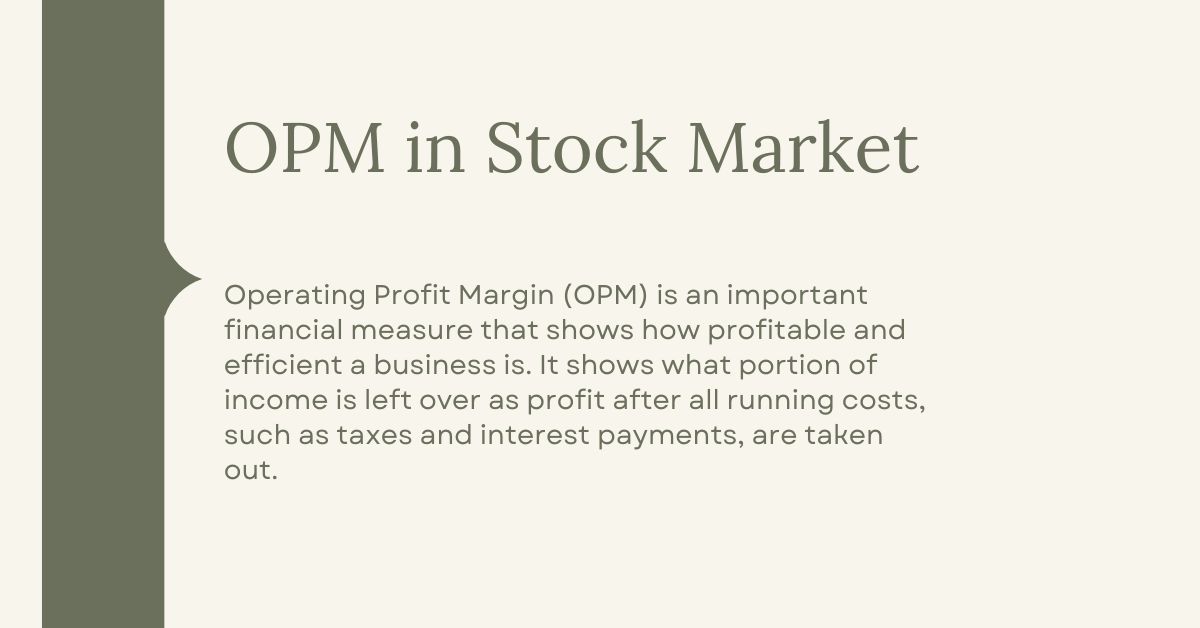The operating profit margin is an important financial measure that shows how profitable and efficient a business is. It shows what portion of income is left over as profit after all running costs have been taken into account, but not taxes and interest payments. This blog talks about what operating profit margin means, how to calculate it, how to understand it, and what part it plays in stock market research.
What is OPM in Stock Market?

Operating Profit Margin (OPM) is an important financial measure that shows how profitable and efficient a business is. It shows what portion of income is left over as profit after all running costs, such as taxes and interest payments, are taken out.
A higher OPM means that a company is successful at keeping costs down and making money from its main business activities. By looking at a company’s OPM, buyers can figure out how profitable it will stay and how much it could grow in the future.
How is OPM Calculated?
To calculate OPM, you first need to determine the operating profit. This is calculated by subtracting all operating expenses, such as cost of goods sold, salaries, rent, and utilities, from the total revenue. Once you have the operating profit, divide it by the total revenue and multiply the result by 100 to express it as a percentage.
Formula: OPM = (Operating Profit / Total Revenue) * 100
Limitations of the Operating Margin
The operating profit margin is a useful way to figure out how efficiently a business runs, but it’s not perfect. First, it doesn’t take into account costs that aren’t related to running the business, like taxes or interest, which can have a big effect on how profitable the business is overall. Also, it might not be directly comparable across different fields or businesses that use different types of business methods.
Also, having a high operating margin doesn’t always mean you’ll be successful in the future because it doesn’t take into account things like the chance of sales growth or changes in the competitive field. In order to get a full picture of a company’s financial health, it’s important to use the operating profit along with other financial measures.
Why Is Operating Margin Important?
There are several important reasons why operating margin is an important business measure. It gives a clear picture of how profitable and efficient a business is. A company that is successful at keeping costs down and making money from its main business operations has a better operating margin.
This measure helps buyers figure out how profitable a company will stay and how much it could grow in the future. Investors can figure out a company’s competitive edge, price power, and general financial health by looking at its operating margin. It also lets you compare companies in the same industry and in different industries, which can help you make smart business choices.
How to Use Operating Profit Margin?
The Operating profit margin can be used in the following ways:
1. How to Judge a Business’s Operational Efficiency:
- Benchmarking: You can figure out how well a company is doing by comparing its operating income to the average for its business or to that of its competitors. It is thought that better cost control and speed lead to a bigger margin.
- Identifying Trends: Keep an eye on a business’s operating margin over time to spot patterns. When margins go up, it usually means that operations are running more efficiently and costs are being managed better.
2. Taking a look at investment opportunities:
- Stock Selection: Companies with stable and high running margins are likely to be the best prospects because they are more likely to make money and have lower risk.
- Due Diligence: When looking at possible purchases, use operating margin along with other financial measures as a key factor.
3. Making Choices for Business:
- Strategic Planning: By looking at the operating margin, you can find places to cut costs and make more money, which will help you make smart choices.
- Pricing Strategies: To make the most money, figure out how changes in prices affect the working margin.
4. Comparing Businesses from Different Fields:
- Industry Analysis: Compare the operating margins of businesses in different fields to learn about the levels of revenue and how the competition works in each field.
5. Keeping an eye on financial performance:
- Performance Tracking: Keep an eye on a business’s operating margin on a regular basis to see how its finances are doing overall and spot any problems that might be happening.
Why OPM is Critical To Analyze a Business for Investment?
Operating Profit Margin (OPM) is a key measure for evaluating a business for funding because it shows how profitable and efficient the business is. A higher OPM means that the company is successful at keeping costs down and making money from its main business activities.
By looking at a company’s OPM, buyers can figure out how profitable it will stay, how much it could grow in the future, and what makes it stand out from its competitors. It helps investors compare businesses in the same industry and in different industries, which gives them useful information for making smart investment choices. People often think that investing in a company with a stable and high OPM is a better way to make money.
What is a Good OPM Percentage?
The OPM percentage that defines “good” changes a lot between companies and businesses. Higher OPM is usually thought to be better, though, because it shows how well a company can control its costs and make money from its core activities.
For example, a tech company with a high OPM might be considered attractive due to its low operational costs. When looking at manufacturing companies, a smaller OPM might still be seen as healthy if it’s within the normal range for the business.
Comparing a company’s OPM to that of its competitors and to past trends can help you figure out if it’s a successful worker. Besides net profit margin, return on equity, and debt-to-equity ratio, think about other financial measures for a full analysis.

